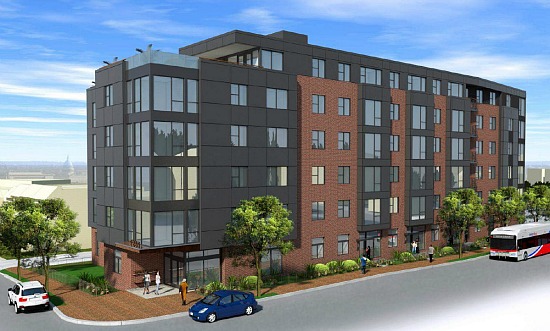 Study: DC Area Will Add 410,000 New Households by 2023
Study: DC Area Will Add 410,000 New Households by 2023
✉️ Want to forward this article? Click here.

A rendering of 2255 Martin Luther King Jr. Avenue SE, where most of the units will be rented to households making 60 percent AMI.
The DC region will add 410,000 households by 2023, according to a new study from researchers at George Mason University.
Of those, 140,000 households will make less than 80 percent of the area median income, suggesting the region will need to add both market-rate and affordable housing to keep up with demand over the next eight years.
The study, from GMU’s Center for Regional Analysis, focused on the housing demands facing the Greater Washington area in 2023 based on current housing and employment trends as well as demographic research. The study was limited to the demand on the housing market, not the future supply of homes, because study author Jeannette Chapman noted it’s “easier to predict people’s behavior than it is the future of the housing market.” The Greater Washington area examined by the study approximates the DC metro statistical area.
Chapman told UrbanTurf the numbers weren’t too much of a shock.
“It’s not a seismic shift,” she said. “We’re going from, in 2011 — which is the most recently completed data — 32 percent households under 80 percent AMI to 33 percent. It’s not fundamentally shifting our demographics. We’re just growing as a region and when you grow as a region, you grow all parts of it.”
story continues below
loading...story continues above
The numbers may, however, allow the city and developers to better plan for DC’s growth, Chapman said.
The retirement of the baby boomer generation and the addition of more low-wage jobs to the region will be the largest contributors to growth in the DC area, according to the study. Of the 410,000 new households, 71,000 will be extremely low income, making less than 30 percent AMI; another 51,000 will make between 30 percent and 49.9 percent of AMI; and another 27,000 will be making between 50 and 79.9 percent AMI.
These low-income households will be added to a region where hundreds of thousands of people are already putting more than half of their income toward housing costs, according to a news release publicizing the findings. To be considered affordable, housing is generally expected to cost up to 30 percent of a family’s income each month. The most recent data on market rents in DC’s Class B housing show average rents ranging from $1,551 a month in South Arlington all the way up to $2,126 a month in DC’s Upper Northwest neighborhoods. And those average rents are for Class B housing, which is older, less updated and generally more affordable than the Class A housing being built in most high-rise rental apartments in DC.
As a result of the high prices and resulting pressure on the most cheaply-priced apartments in the DC area, Chapman said, “there’s a lot of people in this region who can’t find housing.”
Meanwhile, the DC rental market is experiencing unprecedented absorption that’s surprising developers. Despite a crush of new, pricey apartments all hitting the market at once over the last couple of years, real estate data show new renters snapping up apartments about as fast as the DC market can offer them up. As of March, there were still about 11,500 Class A units scheduled to be built in DC proper over the next three years.
An earlier version of this post incorrectly attributed data to DC rather than the Greater Washington Region. The post has been updated.
See other articles related to: affordability, affordable housing, demographics, george mason university
This article originally published at https://dc.urbanturf.com/articles/blog/study_dc_will_add_400000_new_households_2023/10041.
Most Popular... This Week • Last 30 Days • Ever

With frigid weather hitting the region, these tips are important for homeowners to ke... read »

Today, UrbanTurf offers a brief explanation of what it means to lock in an interest r... read »

A new report from DC’s Office of Revenue Analysis highlights how millennials and wo... read »

The 30,000 square-foot home along the Potomac River sold at auction on Thursday night... read »

An application extending approval of Friendship Center, a 310-unit development along ... read »
DC Real Estate Guides
Short guides to navigating the DC-area real estate market
We've collected all our helpful guides for buying, selling and renting in and around Washington, DC in one place. Start browsing below!
First-Timer Primers
Intro guides for first-time home buyers
Unique Spaces
Awesome and unusual real estate from across the DC Metro













